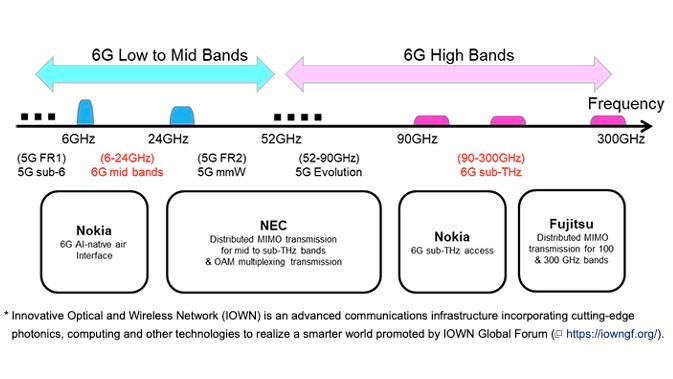
- Japanese operator is ploughing resources into 6G research
- It has brokered relationships with three major telecoms tech vendors
- Fujitsu, NEC and Nokia are the key 6G R&D partners
Always keen to be at the forefront of cutting-edge telecoms technology developments, giant Japanese operator NTT has brokered research and development (R&D) relationships with three key vendor partners to advance its 6G R&D efforts.
NTT and its mobile operator business NTT DOCOMO are to conduct multiple tech trials with Fujitsu, NEC and Nokia as part of a programme to ensure 6G technology is ready for commercial deployment by 2030. The trials will focus on the development of new mobile communications technologies suitable for use with high-frequency spectrum in the millimeter and sub-terahertz bands (above 6 GHz), as well as in the sub-6 GHz spectrum bands being used for 5G services. It will also include work on artificial intelligence (AI)-enabled wireless transmission methods.
Indoor trials with the vendor partners will begin in March 2023, followed by outdoor trials. NTT will then share the results of the trials with global research groups, standards bodies and attendees at various industry conferences.
Fujitsu will be involved in trials based on the use of radio waves in the 100 GHz and 300 GHz sub-terahertz bands, which “represent promising candidates for use in 6G to realise a high-speed communication technology with radio wave propagation that is not affected by obstacles”, noted the Japanese vendor in this announcement. In addition, it will work with NTT and NTT DOCOMO to develop a high-frequency wireless device based on compound semiconductor chip technology. This will be built using multiple elements, such as gallium nitride and indium phosphorous, and will enable faster processing than silicon-based chips.
The main aim of Fujitsu’s work with the operators is to identify ways in which broadband wireless communications delivering data at 100 Gbit/s or more can be enabled, even in areas where there are physical obstacles, mainly using a network topology known as distributed MIMO. This will allow “high-speed communication by simultaneously transmitting different signals from multiple distributed transmitting antennas and separating the signals received by multiple receiving antennas”.

NTT and NTT DOCOMO are working with Fujitsu, NEC and Nokia on multiple 6G trials
The trials involving NEC will also include distributed MIMO architectures for use in lower spectrum bands (see diagram, above). NEC will also work on the development of network operations tools that enable the spatial multiplexing of high-frequency bands to deliver very large wireless transmission capacity; technology that will enable reduced device power consumption; beamforming capabilities; AI-enabled network optimisation and signal processing. See this announcement for further details.
Nokia will work with NTT and NTT DOCOMO on trials that aim to show how mid-band network performance can be enhanced using AI-based air interface technology (using AI-based learned waveform techniques in the transmitter with a deep-learning enabled receiver), and to illustrate how “high-data rate beamformed access can be achieved in a high-frequency band at 140 GHz”.
In yesterday’s announcement, Nokia noted: “These technologies have the potential to substantially improve deployment flexibility and to increase network throughput beyond that of 5G in the respective spectrum bands and without necessarily increasing energy consumption. Providing high-rate access will be important in enabling enhanced and new use cases in the 6G era, such as multi-modal mixed-reality telepresence and remote collaboration, massive twinning and collaborating robots.”
The trials will take place in Stuttgart, Germany, as well as in Japan.
Bringing 6G to market is one of the primary aims of NTT’s Innovative Optical and Wireless Network (IOWN) project, which focuses on the introduction of a communications infrastructure for the delivery of next-generation services. In the case of 6G, “DOCOMO and NTT are actively conducting 6G research and development, combining NTT's optical and wireless technologies with DOCOMO's mobile technologies,” noted the operator in this overview of its new 6G R&D efforts.
NTT is also heavily involved in Japan’s national efforts to become the leading 6G nation. Along with its rival Japanese mobile operators KDDI, Rakuten and SoftBank, it is a member of the Beyond 5G Promotion Consortium, which aims to ensure Japan is setting the tone for global 6G efforts and steering the path towards tech specifications and guidelines for the 6G era. To that end, the Japanese government has been forging international alliances with the US, Finland the UK to attract international support and help.
- Ray Le Maistre, Editorial Director, TelecomTV
Email Newsletters
Sign up to receive TelecomTV's top news and videos, plus exclusive subscriber-only content direct to your inbox.




